Listed below are Morse Code keys known to have been mass-produced in New Zealand for use in landline telegraphy, commercial radiotelegraphy, the military, or amateur radio.
This page features traditional “straight” keys (sometimes called “pump” keys). Please see the links at the bottom of the page for other types of key made in New Zealand.
If you know of other keys, or have additional information of photographs to share, please contact the editor.
Akrad Radio key

Akrad keys. Photos: CT4SL and ZL2WT
Akrad Radio, based in Waihi, made a key as part of a Morse practice set during World War II. These were described as conventional, inexpensive and fairly robust.
Akrad Radio Corp (the name Akrad stood for Auckland Radio) was founded in 1932 by Mr KM Wrigley. In 1940 there were about 30 staff and by the end of the war this had increased to a little over 100. Akrad made many parts for the ZC1 transmitter/receiver and also the buzzer assembly for army field telephones.
Branch 80 key
In the early 1980s the newly formed Hibiscus Coast Amateur Radio Club – NZART Branch 80 (since renamed the Hibiscus Coast Radio Society) made a production run of straight keys with code practice oscillators.
As explained by club secretary John Bell ZL1FB (SK) in April 2000:
“Apparently it was the brainchild of a founder and past president Trevor Fergusson (ZL1FU, now SK) when the club was founded and there were many CBers wanting to become fully fledged Amateurs. This was evidenced by a good number of the attendees at the inaugural meeting having CB calls. We still have some metal boxes to enclose the oscillators but it seems there is only one key left. These were about the size of the ZC1 key, but copies of the standard brass key, hand-made from square aluminium stock, centre-pivoted with an adjustable spring and a contact towards the handle. The main arm extended past the pivot to a stop. It resembled the Tricity House (Supreme) brass key but had the spring on the handle side of the pivot. A working model with oscillator was mounted on a piece of hardboard, complete with the instruction sheet. Unfortunately it has been ‘pirated’ so that only the key and sheet remain. Some day I shall rebuild it as part of the Club history.”
If you have a photo of the Branch 80 key, please contact the editor.
Assembly instructions for Branch 80 Code Practice Oscillator
Consol Tele Co 1902 No: 289
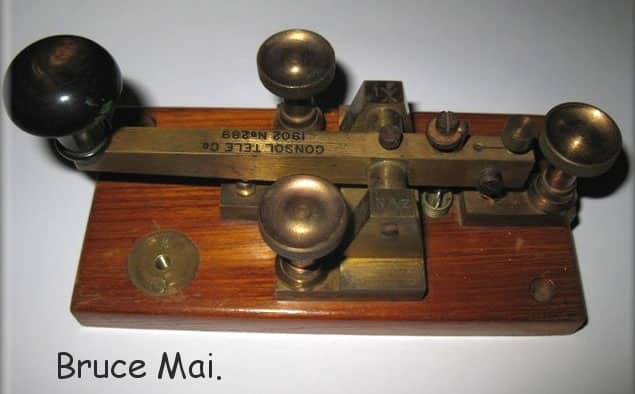
Consol Tele Co GPO style Morse key
From the morsemad website:
Mad keen telegraph collector from Auckland – Bruce Mai – sent me this photo, and states: “I’ve recently got hold of a standard GPO single current key. It has milled head terminals and turned horn knob which unscrews to be screwed onto the teak base. It has makings N^Z stamped with the words “CONSOL TELE Co 1902 No: 289″ on the key bar. It is housed in its own beautifully made teak case.”
Curator’s note: I believe the manufacturer’s name was Consol Tele Co 1902, and this was their product No. 289. Although the N^Z mark indicates it was property of the New Zealand government, I have not yet established whether it was made in New Zealand. If you have information, please contact me.
Ensign key
An advertisement for the Ensign key appeared in the 1942/43 Lamphouse Annual. The catalogue number was PH2, and the cost 27/6d. I have yet to confirm that this key was made in New Zealand.
Lamphouse Heavy key
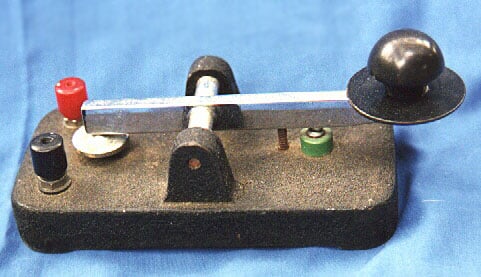
Lamphouse Heavy morse key

The Heavy Morse Key was ‘half price’ in the 1946 Lamphouse Annual catalogue
This is an interesting key. The gap is adjusted by a large disc-headed screw, which acts as a backstop.
The spring tension is adjusted from under the heavy cast iron base.
It is not a pretty key, but it has a good action.
I am still attempting to confirm that this key was made in New Zealand.
In the 1945 Lamphouse Annual the catalogue number was TH4 and the cost was 13/6d.
Lamphouse Practice key
Described in the 1942 and 1945 Lamphouse Annuals as “Low priced practice keys. Good movements. Steel Fittings.” Catalogue numbers PH4 or TH4. Price 13/6d.
A&W McCarthy keys, Minstrel Radio key
The Dunedin firm A&W McCarthy dealt in radios, guns and outdoors equipment. They sold straight Morse keys of at least two types, as well as a lightweight semi-automatic key.
We do not know who made the straight keys (or where), whether they were made especially for McCarthy or simply purchased by McCarthy and re-labelled. One type had a decal with the Minstrel brand, which appears to have been McCarthy’s house brand.
There are two types of A&W McCarthy badge as well, one in metal and the other in plastic. Both types of badge have been seen on both types of key. The badge reads:
A. & W. McCarthy.
Dunedin and Invercargill.
It also isn’t known which of the straight keys came first, or whether they were sold at the same time. For the moment, we’ll describe them as Type 1 and Type 2.
McCarthy Type 1
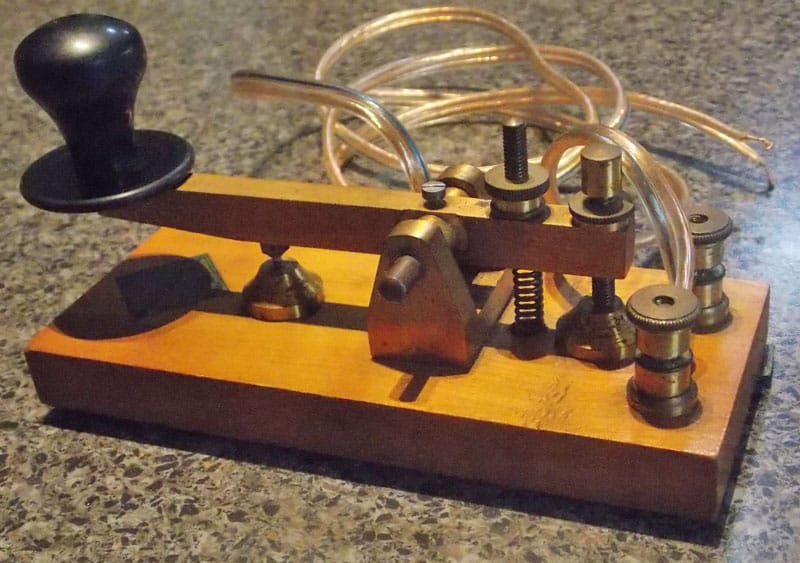
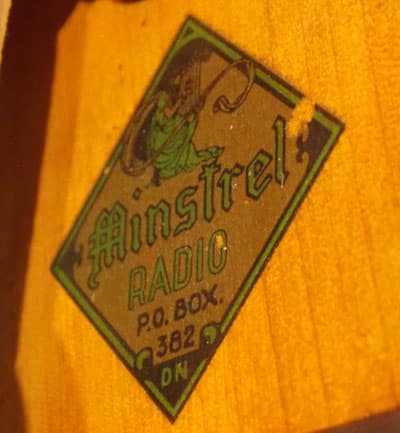 Type 1 keys have one set of contacts (i.e. 2 wiring terminals), a McCarthy plaque on the edge of the base below the knob, and a decal on the base under the knob, which reads “Minstrel Radio, PO Box 382 DN.”
Type 1 keys have one set of contacts (i.e. 2 wiring terminals), a McCarthy plaque on the edge of the base below the knob, and a decal on the base under the knob, which reads “Minstrel Radio, PO Box 382 DN.”
There is good reason to believe that Minstrel was McCarthy’s own brand. Research by Herman Willemsen VK2IXV has revealed that:
1. The PO Box address on the Minstrel label is the same as shown for A&W McCarthy in this April 1930 advertisement for their radio display at a local show.
2. McCarthy sold Minstrel brand radio receivers (see this advert from 1935), which they may have manufactured themselves. McCarthy applied for a license to manufacture radios in 1946 and it is possible they were making them before the war too.
One of these keys has been seen without the McCarthy badge, suggesting the key might have been available from other suppliers.

Here is a Minstrel-labelled key with a McCarthy plaque but no knob skirt:
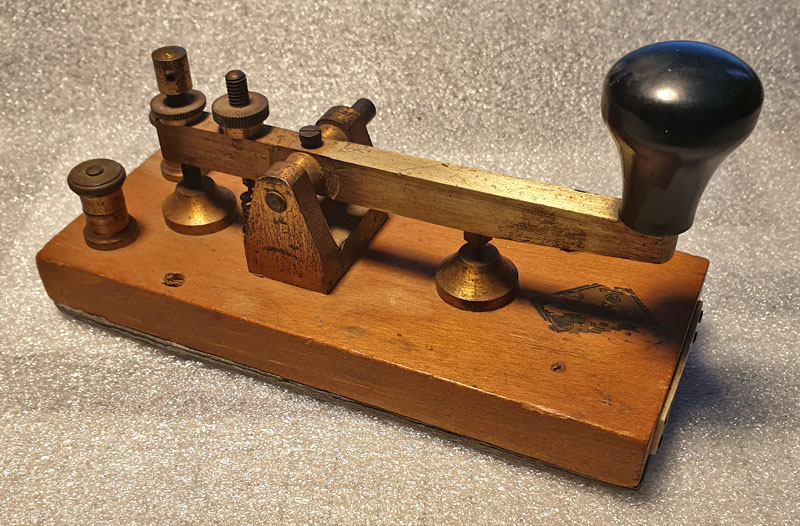
A&W McCarthy key. Photo: VK2IXV
McCarthy Type 2
Details coming soon!
Monarch key
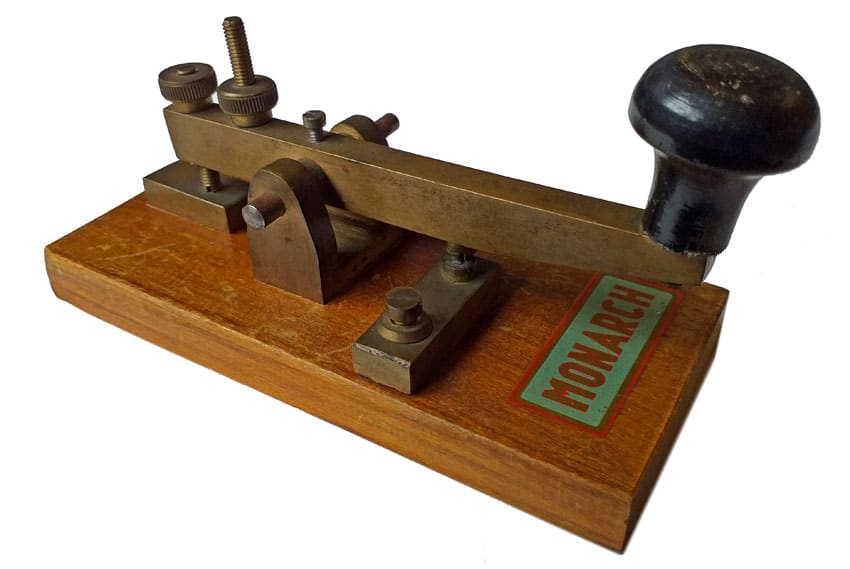
Photo: ZL1NZ
The Monarch key may have been made in New Zealand, but the evidence, so far, is circumstantial:
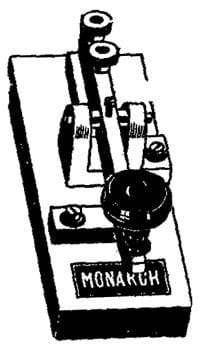 1. The timber base looks like rimu (NZ red pine), a very common and widely-used type of timber in New Zealand.
1. The timber base looks like rimu (NZ red pine), a very common and widely-used type of timber in New Zealand.
2. An advertisement for the Monarch key, illustrated with a simple line drawing, appeared in the 1942/43 Lamphouse Annual, a popular NZ catalogue of radio and electrical parts. The catalogue number was PH1, cost 22/-d.
3. A Monarch key is in the collection of Te Manawa museum in Palmerston North, NZ. The museum describes it as “Telegraph key or Morse code transmitter c.1939-1945, used for World War II training”. The key is mounted on a board along with a Morse Code practice buzzer made by Akrad, a well-known maker of radios in Waihi, NZ. Akrad (the name stood for “Auckland Radio”) also made Morse keys for practice sets (see information at top of this page).
The Monarch key has brass and steel components on a varnished timber base with a “Monarch” decal under the knob. Dimensions are:
Length overall: 160mm
Length (base): 147mm
Width: 70mm
Height: 80mm
Weight: 375g
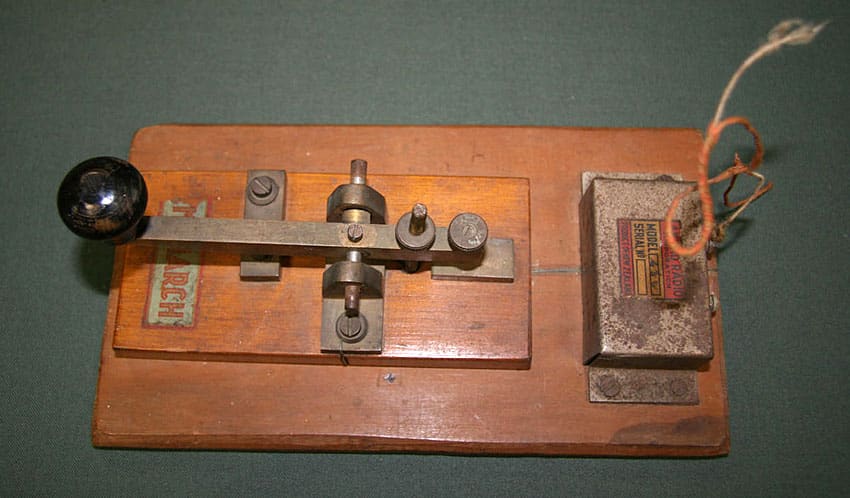
Photo: Te Manawa museum
New Zealand Post Office key (maker unknown)
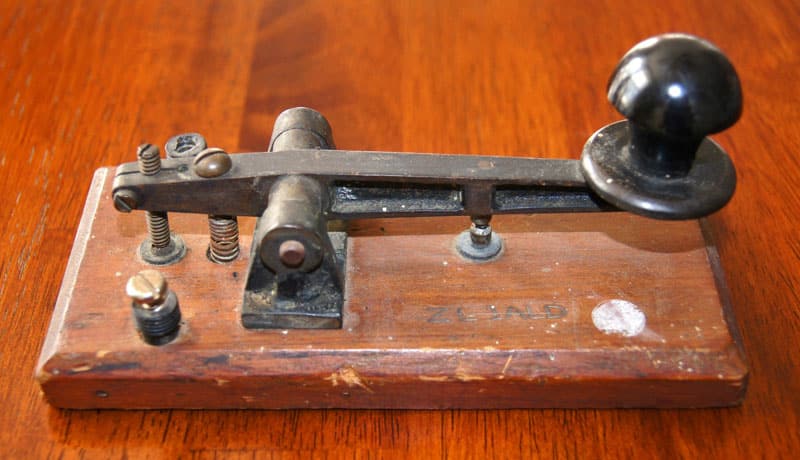
As listed on telegraphkeys.com. No other information available.
New Zealand Post Office key by Potter & Co

As listed on telegraphkeys.com. No other information available.
Ripley’s Radios key

Ripley’s Radios morse key in collection of MOTAT, Auckland
Ripley’s Radios was a shop in Customs Street, Auckland and may have simply been an importer and distributor of this key which is made of brass on a wood base.
MOTAT describes this key as from the 1930s.
RNZAF PS4707 key

As listed on telegraphkeys.com. No other information available.
RNZAF PS5785A flameproof key
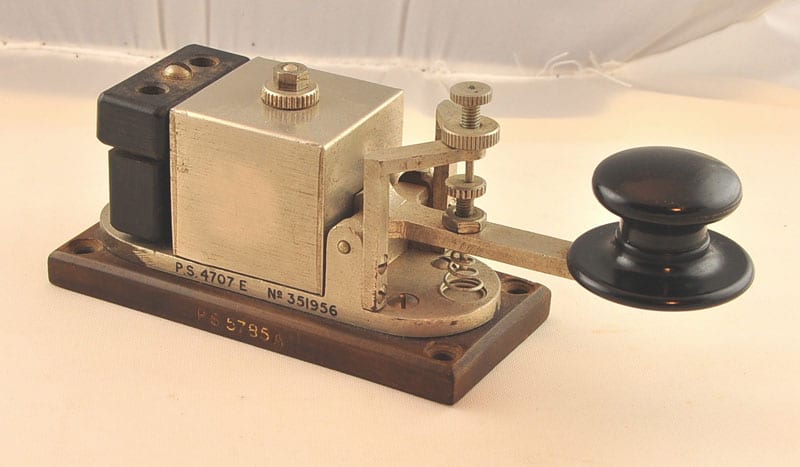
As listed on telegraphkeys.com. No other information available.
RNZAF Wigram key
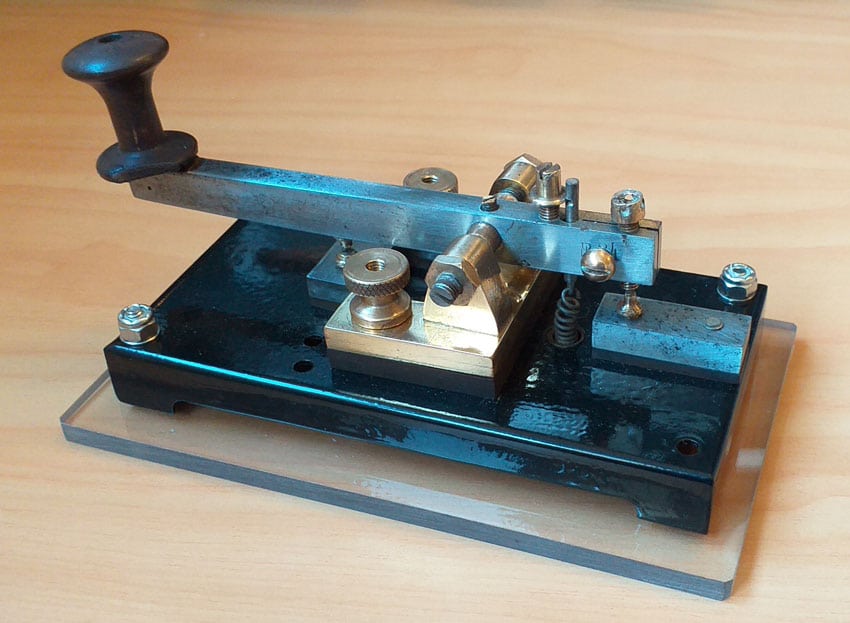
Wigram key mounted on acrylic. Photo: ZL1NZ
Around 1941 the RNZAF were experiencing shortages in many areas. Prior to WWII most telegraphy equipment had been imported from England. The standard Post Office key made by Elliott Bros. appears to have been one of the keys commonly used.
To overcome the shortage, trainees in the E&W School made Morse keys as their Trade Test Pieces. (The more usual test pieces were a metal toolbox and a couple of special tools.) The key made by the trainees has become known as the Wigram Key. The base of the key is made from folded sheet metal and the arm is made from steel.
Wigram keys were probably then used by Air Force recruits learning Morse Code.
Supreme keys
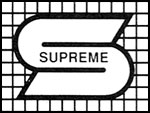 Supreme keys were made in New Zealand by at least three different people, and were sold by Tricity House, at 209 Manchester Street, Christchurch. Supreme was the brand name used for various products sold exclusively at Tricity House.
Supreme keys were made in New Zealand by at least three different people, and were sold by Tricity House, at 209 Manchester Street, Christchurch. Supreme was the brand name used for various products sold exclusively at Tricity House.
Supreme key version 1

Supreme morse key in plain brass. Photo: SM5LNE
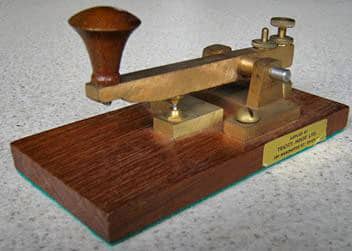 The original, and by far the most popular, Supreme straight keys were made by Eric Sorensen ZL3OQ (1909-1990), who also made the Supreme semi-automatic key. Most were plain brass but a few chrome-plated versions were made.
The original, and by far the most popular, Supreme straight keys were made by Eric Sorensen ZL3OQ (1909-1990), who also made the Supreme semi-automatic key. Most were plain brass but a few chrome-plated versions were made.
Pictured: A Version 1 key with the Tricity House label, but no disc under the knob (reason unknown).
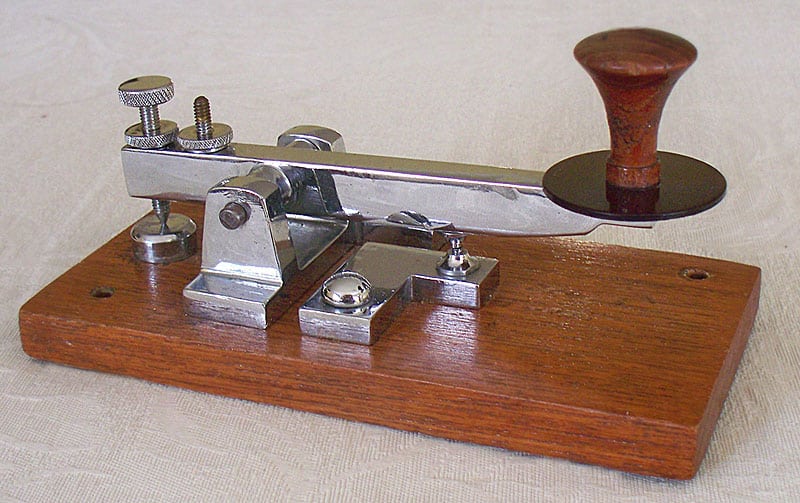
Supreme morse key in chrome. Photo: ZL3TK
Buyers could also choose the colour of disc under the knob. The following colours have been seen: black, brown, red, orange, yellow, blue, translucent red and clear.
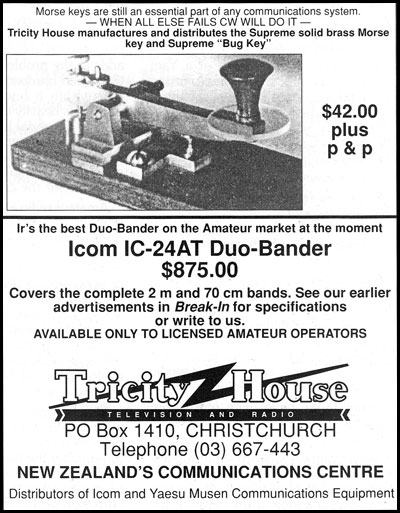 “The tension spring is stainless steel. The base is made from rimu (NZ red pine) and the knob from teak. Both were lacquered. At first the base was also made from teak, but it became too hard to get and too expensive. The base measures 15cm x 7.5cm and the key weighs 0.4kg. Distinguishing features include diamond-knurled nuts, a coloured Perspex disc under the knob and a layer of green baize (billiard cloth) under the base.”
“The tension spring is stainless steel. The base is made from rimu (NZ red pine) and the knob from teak. Both were lacquered. At first the base was also made from teak, but it became too hard to get and too expensive. The base measures 15cm x 7.5cm and the key weighs 0.4kg. Distinguishing features include diamond-knurled nuts, a coloured Perspex disc under the knob and a layer of green baize (billiard cloth) under the base.”
– Herman Willemsen VK2IXV
Supreme keys sold for $34.50 in 1986, $39.95 in 1987, $41 in 1989 and $42 in 1990.
Pictured: Part of a Tricity House advertisement in the November 1990 edition of Break-In magazine.
Supreme key version 2

Supreme key, version 2. Photos: ZL3VX
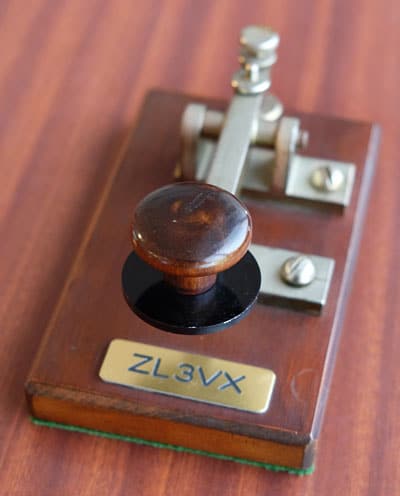 Hi-Tec Aerials, which made Supreme aerials for Tricity House, was asked to supply Supreme straight keys some time around 1990, and continued doing that until about 1995. Demand was low and only about 30 were made.
Hi-Tec Aerials, which made Supreme aerials for Tricity House, was asked to supply Supreme straight keys some time around 1990, and continued doing that until about 1995. Demand was low and only about 30 were made.
Ron Parry ZL3VX, who was a partner in Hi-Tec Aerials, recalls that the keys were made for his company by a contractor, but he has forgotten the maker’s name. Can anyone help with that?
In February 2000 the Com-Centre in Auckland still had a few for sale.
These keys are similar to the Version 1 keys by Sorensen, but have a different knob (a drawer pull perhaps?) and the hot terminal is located on the right-hand side of the base beside the earth terminal.
The base measures 145cm x 85cm, making it about 1cm wider than the Version 1. Metal parts are brass and the type of timber is not known at this time.
Supreme key version 3

Improved Supreme morse key. Note the different knob and finger disc style, as well as the improved gap adjuster. Photo: John VR2GP

In 1993 the price of a Supreme key was $99.75, but this was an improved model. It was described as “The new refurbished velvet touch of the Supreme solid brass Morse key.”
It is believed to have been made by someone named Paul, in Christchurch. (Please contact the curator if you have information.)
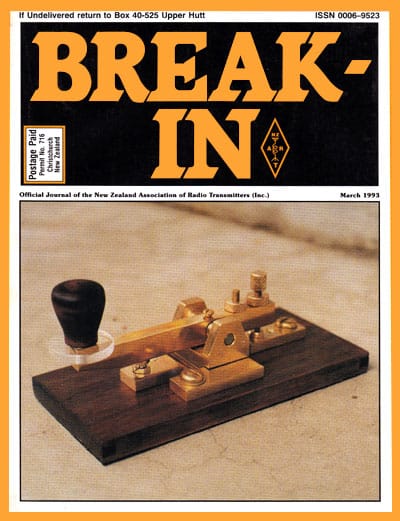 This key was pictured on the cover of Break-In magazine in March 1993 but, unfortunately, there was nothing in the magazine about the key.
This key was pictured on the cover of Break-In magazine in March 1993 but, unfortunately, there was nothing in the magazine about the key.
Trident key
A radio amateur living north of Auckland has told me he has a NZ made key called a Trident. Details and a picture will be added to this page, once I receive them.
Ultimate key

A restored Ultimate key, with newly made knob, new contact-spacing screw and varnished base after paint was stripped. Photo: VK2IXV
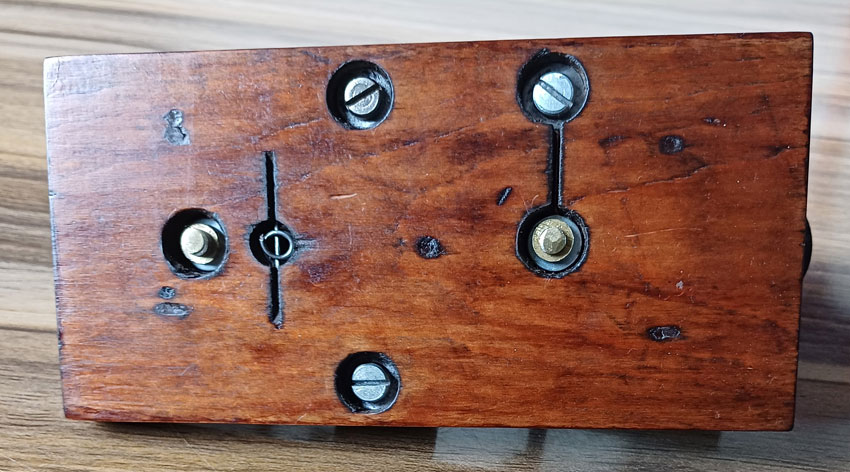
Photo: VK2IXV

The Ultimate key was ‘half price’ in the 1946 Lamphouse Annual catalogue.
The Ultimate key was made by Radio (1936) Limited, an Auckland company. RJ (Jack) Orbell ZL1AX was the Chief Engineer and a Director of that company, and many of its products, including radio receivers, carried the Ultimate brand name.
The description of the key in the 1942 Lamphouse Annual catalogue is as follows: “Heavy brass arm and bridge. Fine adjustment of spacing and tension provided. Wooden knob and finger rest flange, ensuring comfortable operation grip. Mounted on wooden base, finished in varnish. Measures 6 ins long, 3 ins wide, 3 ins high (overall).” Catalogue number PH111, 16 shillings and 9 pence each.
ZC1 key

WT 8 Amp No 2 Morse key, as used on New Zealand ZC1 transmitter/receiver
This key is more commonly known overseas as the WT 8 Amp No. 2 Key. However, in New Zealand it is usually referred to as the ZC1 key after the World War II ZC1 General Service HF Transmitter/Receiver to which it was fitted.
In 1993 Tony Smith G4FAI published in Morsum Magnificat (edition 28) the initial results of a worldwide survey into the WT 8 Amp key. He reported that there were over 100 known versions of this key. Five of these versions had the markings “NZ” either under the base or on the side of the arm under the knob.

The WT 8 Amp Nr 2 keys made in New Zealand are labelled ‘NZ’ on the bottom.
“The first maker of the ZC1 key was Collier & Beale, a radio design and manufacturing company based in Wellington. They designed the ZC1 Army radio sets, including the associated Morse key, headphones and microphone. In 1942, Collier & Beale was given the go ahead for the initial production of only 165 ZC1 Mk1 sets. However, the mass production of the ZC1 Mk1 (and around 1943 the Mk2) was carried out by Radio (1936) Ltd, Auckland and Radio Corporation of NZ Ltd, Wellington on behalf of the NZ Government. Therefore, there were three manufacturers of the ZC1 key.”
– Hermanus Willemsen VK2IXV
(Some people have suggested that the ZC1 keys were made by Akrad Radio Ltd in Waihi which made other parts for the ZC1. However, Ted Grant, who worked for Akrad, says this is not correct.)
A couple of features that help to distinguish New Zealand versions from others are:
- rounded corners on the 3 “bridges”
- hex head (plus slot) screws on the three terminals












